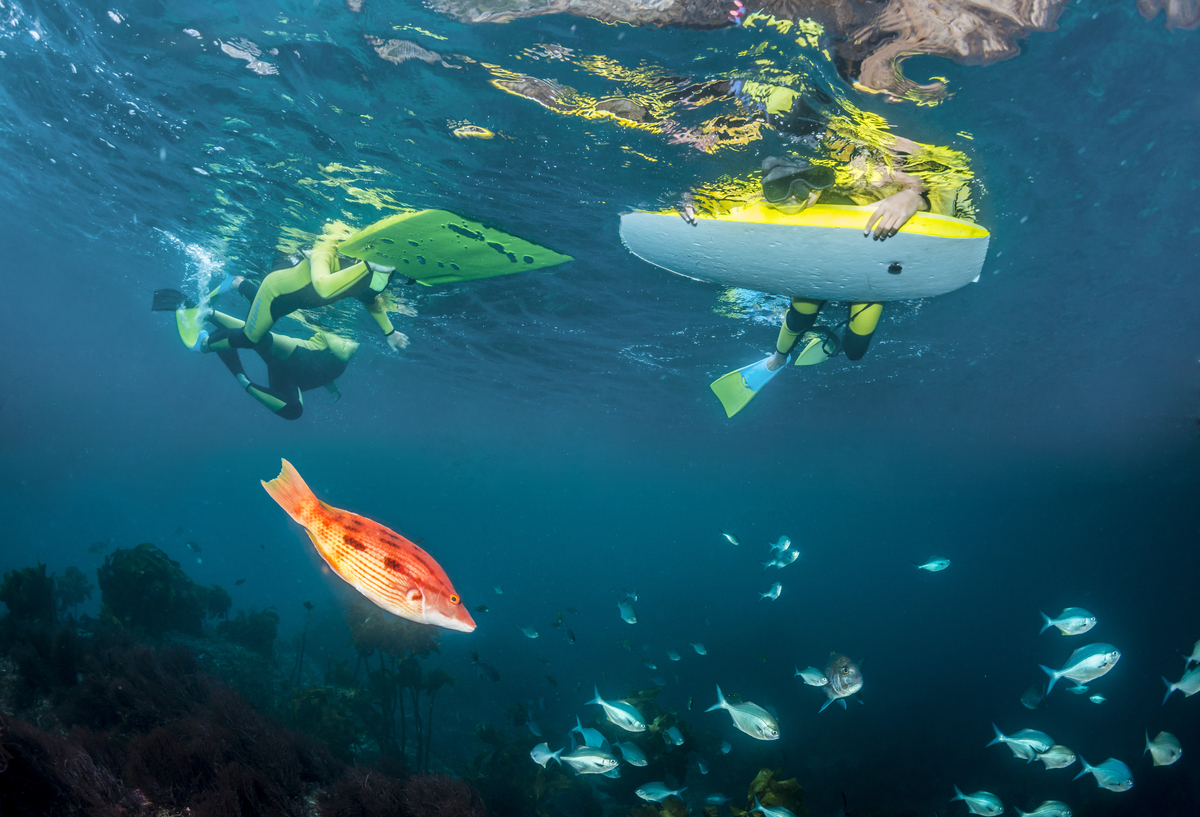 EMR students at the Poor Knights Islands marine reserve, photo by Darryl Torckler
EMR students at the Poor Knights Islands marine reserve, photo by Darryl Torckler
In this important section of the How to Kit we look at experience and best practice for working with the following sections of your community:
- The Broader Community - Socio-economic Research
- Tangata Whenua, Tangata Moana
- Recreational Fishers
- Commercial Fishers
- Ministry of Primary Industries (MPI)
- Department of Conservation (DoC)
Resources supporting these topics can be found and downloaded from our Library folder Social Science & Community Engagement
A starter list of suggestions for community consultation include:
- participating in local events with stalls and displays
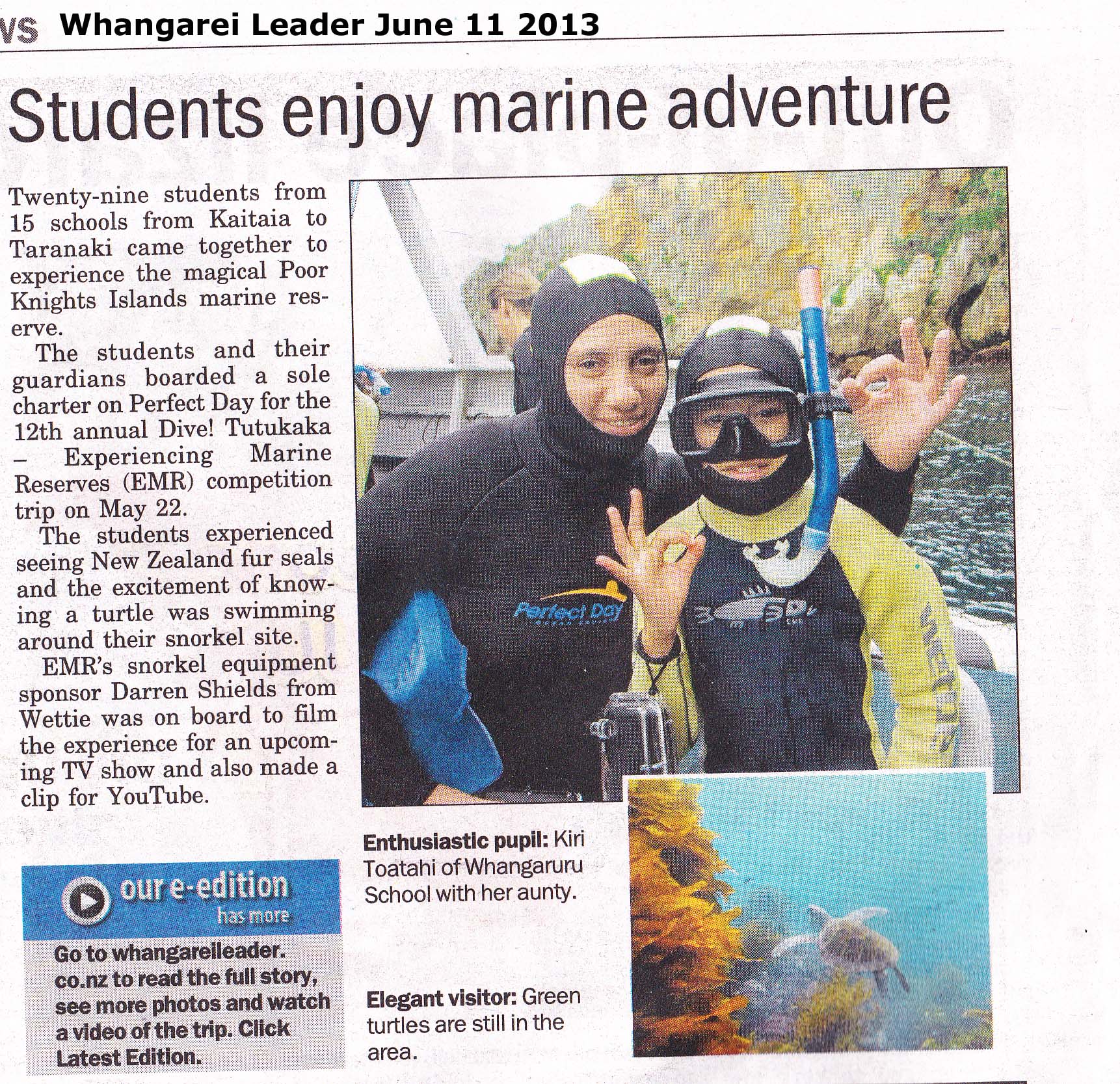 EMR students and family exploring our marine reserves
EMR students and family exploring our marine reserves - organizing coastal walks
- organising information talks and film evenings
- working with school children
- using community newspapers for coastal stories
- "open houses"
- running videos in local shops
- focusing visitor programmes on marine reserve issues
- doing press releases and providing stories to your local media
- partnering with or supporting EMR events for your schools or community groups
- going and sitting down with leaders and people of influence in the various sectors of the community asking for their help, guidance and involvement
The point behind this list is that somewhere in the process of formulating a marine reserve proposal, you must somehow get to grips with 'the public'. One of the criteria for reserve establishment is demonstrated widespread public support for the final application. Clearly, this will not be a simple or a short experience. However, it can be an incredibly diverse and exciting one.
The idea of 'no-take' marine reserves and the principles behind them are still really new for the vast majority of New Zealanders. But this doesn't mean they can't be educated, involved and persuaded of the worth and value of your proposals. Every successful marine reserve campaign in New Zealand to date has witnessed a huge upswell in public awareness and support as the campaign progresses (and for a long, long time to come after the establishment of the reserve!)
One thing to remember is that 'consultation' cannot be divorced from 'information gathering' in respect of your work with the community. Go through the Information Gathering directory carefully at the same time as this one. Particular references to pages on public opinion and visitor use surveys are listed below.
It is unwise to approach this aspect of your consultation and investigation work with preconceived ideas about your community, such as who represents what part of the community, their level of knowledge or their attitude to your proposal. What will work wonders in the vast majority of situations is simply to be positive, to be energetic, to be open to involvement and to be responsive, learning from your community so that you can formulate the best marine reserve application possible.
This said, you have every right to get up on your soapbox and sing the benefits of marine reserves from the rooftops, just as your opponents have the right to be heard and considered. We have so much information (growing all the time) about the need for and the incredible benefits of having more marine reserves in this country. We have an increasingly supportive policy environment, and the opportunity to move forward with marine conservation partnerships with tangata whenua. New approaches are being tried out all the time. It is up to you to discover the marine reserve lying in wait within the minds of your neighbours!
Ideas for Engagement with your community
➢ Is the ocean in the area you're investigating the same as it used to be? You will often find evidence within the local community that the area you are looking at has suffered severe depletion in health due to pollution or overfishing; the protection of the area to restore health and marine life may be of special interest to the community.
➢ Focus on the conservation values of your area. Get local students and divers to help make a list of the biodiversity present in the area. Use traditional and local knowledge to draw a picture of the area. Present and inform the wider community of your findings.
➢ How many educational institutions are in proximity to the area? Marine reserves offer huge educational benefits and provide a great focus for exciting scientific, biological and social studies. Talk to educators in your areas about using marine reserves studies in their study program. Check out the Education section of this website and discuss this resource and your ideas with local teachers. Discover the magic things that happen with kids and their parents and teacher in the Experiencing Marine Reserves program. If there is one running in your area contact them, you will find they will be openly welcoming you to become involved. If there is no program in your area consider making contact with the EMR coordinators and the Mountains to Sea Conservation Trust to investigating starting an EMR program in your area.
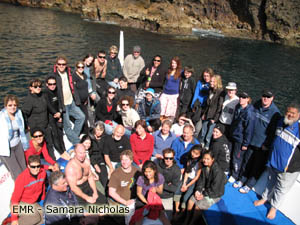 EMR Wananga at Whirinaki, NorthlandThe EMR model and programmes now have expanded to most regions in the country. One exciting part of the EMR experience is the 'action' which each student is encouraged and supported to create. The action is focused on doing something to support marine conservation. Kids being kids have come up with some amazing contributions. In some cases, students take the bull by the horns and develop their own proposal for a marine reserve in their own areas.
EMR Wananga at Whirinaki, NorthlandThe EMR model and programmes now have expanded to most regions in the country. One exciting part of the EMR experience is the 'action' which each student is encouraged and supported to create. The action is focused on doing something to support marine conservation. Kids being kids have come up with some amazing contributions. In some cases, students take the bull by the horns and develop their own proposal for a marine reserve in their own areas.
Here is a video produced by two Northland students Ryan Torckler and Trace Savage. It was a standout project which has made a brilliant job of introducing a proposal to the community for the Mokihinau Islands situated in the Hauraki Gulf off the coast of Warkworth north of Auckland.
Student 'action' project proposes a marine reserve for Mokihinau Island
➢ Think outside the square you live in. An unusual strategy for involving the public in your campaign could be to organise a free overnight trip to your nearest marine reserve. Organise snorkel equipment and get the group in the water. Organise an expert to make a presentation in the evening. Have heaps of nice food! The possibilities are endless.
➢ When you are challenged or criticised, remember you are embarking on a mission to enrich your community in all sorts of ways. Have no, I repeat no, hidden agendas and nothing to be afraid or ashamed of. Imagine the knowledge that you and your partners have achieved something that your area will be proud of forever. It has happened – it can happen – it will happen!
The Broader Community - Socio-economic Research
It is extremely useful to spend time at the beginning of your project to become familiar with the work done here and in NZ on understanding people's relationship with marine conservation, ecology and in particular no-take marine reserves and the process of creating them. In our Library folder Social Science & Community Engagement there is a listing of research (38) papers and documents with brief descriptions to guide your reading and study. All these resources are selected because they add something to understanding how to work with communities on marine conservation and how to create an effective process. In New Zealand and internationally it has been shown time and time again that how people engage with marine conservation campaigns or planning processes has a significant bearing on how successful they are. Social science in its many forms provides tools for getting this right. These resources are coded in our download list in the following categories:
Consultation examples
- How to
- Economic analysis
- Ecosystem valuation
- Benefits
- Marketing conservation
- Iwi-hapu
- Opinion surveys
Note: In the document list you search for keywords via the filter box
This collection of resources has a collection of key NZ and international references. Lessons learned from things we have actually done here in New Zealand are by far the most valuable. People naturally relate to discussions of these NZ learnings easier. That said there is a wealth of experience now gleaned from doing large-scale marine protection in places like the US and Australia. It is useful to know what has worked and what has not worked in all these cases. Unlike in New Zealand other countries like Australia and the US have spent large amounts of money on the business of creating marine protected areas generally and marine reserves specifically, likewise a lot of effort has gone into the evaluation of best practice.
Please note that valuable resources on process also are found in some of the other Library folders. For example, in the Case Studies folder, there are many documents that have important process examples, comments and learnings. In the Traditional Management folder, there are also another collection of documents that dive into other case studies and papers on this topic.
In the Consultation examples collection there a number of documents covering a range of examples ranging from how groups handled submissions, designed opinion surveys, theory of engagement with communities to an example on introducing a voluntary fishing code.
The categories of economic analysis, ecosystem valuation and benefits arm you with a huge range of positive ideas of how you can talk about marine reserves.
The 'How To' category contains a collection of NZ documents mostly produced by DoC as well as documents from international sources. The IUCN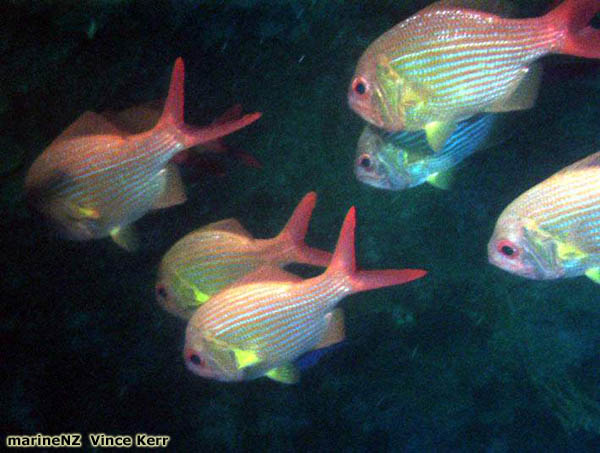 documents are particularly valuable and important for the reason that huge resources have gone into the supporting research and information and production but also because they are linked to the UN biodiversity goals and directives that we as a country are signatories to. These UN biodiversity goal statements, indicators and targets underpin our legislation and policy. The trick here is getting it done on the ground, on the water and in our communities.
documents are particularly valuable and important for the reason that huge resources have gone into the supporting research and information and production but also because they are linked to the UN biodiversity goals and directives that we as a country are signatories to. These UN biodiversity goal statements, indicators and targets underpin our legislation and policy. The trick here is getting it done on the ground, on the water and in our communities.
A note on the DoC publications, most of the documents are dated between 2002 and 2005. You might question are these manuals outdated? Our response to this is 1) The period between 2000 and 2005 was a period where DoC was actively involved in leading marine protection in NZ and achieving progress with biodiversity goals. Parliament even made a special allocation of some millions of dollars to support DoC getting on with it. As a result, a great deal of good quality work was done during this period on process and consultation with communities around marine conservation. We argue that there is still value in this work. Since 2005 the Department's political bosses have slashed funding to this aspect of DoC's responsibility and preferred DoC to take a more support backseat role in MPA process. As a result work on the MPA process has slowed somewhat.
Evaluation of the effectiveness of each process is an extremely important aspect in becoming better at MPA process, (see Bernstein 2004). Expect a lot more work to come out in the near future on how well we have actually done with the first Marine Protection Forums run under the current MPA Policy.
Make sure you browse the papers on opinion surveys - this is must-read stuff - this is what New Zealand people actually think about marine conservation and marine biodiversity protection. There is some surprising information demonstrating how we as a nation are only just beginning to come to grips with the issues around caring for the sea and actually getting on with it. The good news here is we know from this body of work that the people of New Zealand actually do want it to happen, (see Eddy 2014).
Lastly, take notice of the paper in the Marketing Conservation folder (Clark & Jason 2002). Are we good at marketing conservation? How should we go about it? The short answer is NO we are not and the good news is we can do a lot better by learning from the 'dark art' of marketing.
Tangata Whenua Tangata Moana
Resources useful to provide background on working with Tangata Whenua can be found in:
Library/Social Science & Community Engagement
Library/ Traditional Management
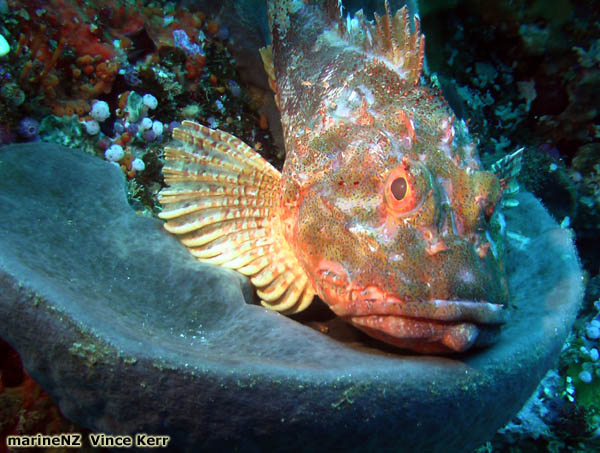 If you study the history of engagement and partnership with Maori in marine conservation in New Zealand you will find a full range of experiences, from seeing amazing leadership, insight and knowledge demonstrated by kaumatua and kuia supporting marine conservation, to court cases where hapu or iwi have challenged marine reserves and withdrawn their support of marine reserves in their rohe totally. Why these differences? Firstly, maori tikanga is essentially hapu or tribal based and there are many circumstances that change as you move around the country from rohe to rohe. Secondly, some tribes have had some success working in partnership with the Government and others have not.
If you study the history of engagement and partnership with Maori in marine conservation in New Zealand you will find a full range of experiences, from seeing amazing leadership, insight and knowledge demonstrated by kaumatua and kuia supporting marine conservation, to court cases where hapu or iwi have challenged marine reserves and withdrawn their support of marine reserves in their rohe totally. Why these differences? Firstly, maori tikanga is essentially hapu or tribal based and there are many circumstances that change as you move around the country from rohe to rohe. Secondly, some tribes have had some success working in partnership with the Government and others have not.
Our goal moving forward is surely, to begin with, a positive goal of achieving a meeting of the minds between our cultures around the goals, the necessity and benefits of having fully protected areas like marine reserves. Indeed in some areas Maori have lead moves to create marine reserves locally. Certainly politically in New Zealand, this is our chosen way of working and moving forward to meet our challenges. The resources offered in this kit are chosen to help create this understanding and deserve your study before you embark on your project.
Maori have a long history of very sophisticated management of the coastal environment and they generally are very concerned about the degradation of the resource. Despite this, they may be uncomfortable with using marine reserves for a tool. So there is much to learn about why this is and much to do to win support and support and engage local Tangata Whenua in the task.
Dealing with the politics
There is little doubt that engaging in a marine reserve project will lead you into all sorts of politics. It should not come as a surprise that the Maori community has a long list of grievances that can spill over into any discussion about management of the sea. Also, it shouldn't be a surprise that Maori communities often have limited personnel and financial resources to deal with a huge range of social, economic and other environmental challenges their people face. It is important to spend serious time listening to the concerns and challenges and to be supportive of the many positive agendas you will discover. Marine reserves are never created in isolation from these things. Having said this, the key task in consultation work is to shift attention to the key conservation issue and the action, which is to create a marine reserve.
Who to talk with
Many people have struggled with this for the simple reason that Maori communities are all unique. Sometimes even at the whanau/hapu level, there can be significant local differences. Another reason stems from our history of creating artificial European-style structures to deal with Maori issues. These are the Trust and Runanga structures that vary tremendously around the country for many reasons. We'd like to offer some simple guidelines to help you through this.
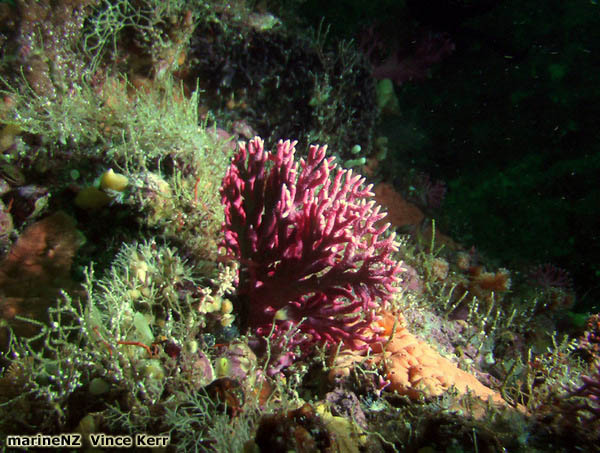 Red coral. Fiordland, photo by Vince KerrWhere you have a runanga established or a significant Iwi Trust operating in the RMA and Treaty settlement area on behalf of the local hapu/whanau you should make contact and ask to meet with senior staff or Trustees to explain your intentions and ask for direction and support. Don't just talk to one spokesperson. You don't have to go to these umbrella groups first, but you definitely need to make this connection as early as possible. In some cases, these people will also be the most appropriate people to work with and possibly lead a marae-based consultation or planning effort.
Red coral. Fiordland, photo by Vince KerrWhere you have a runanga established or a significant Iwi Trust operating in the RMA and Treaty settlement area on behalf of the local hapu/whanau you should make contact and ask to meet with senior staff or Trustees to explain your intentions and ask for direction and support. Don't just talk to one spokesperson. You don't have to go to these umbrella groups first, but you definitely need to make this connection as early as possible. In some cases, these people will also be the most appropriate people to work with and possibly lead a marae-based consultation or planning effort.
Where there is an active marae, there will be a marae committee and there will be a secretary of the committee. Contact the secretary and ask to be able to address the marae executive or committee. At this meeting explain your intentions and ask for advice and support on how to best proceed in taking the information and idea to the people. At this stage, it is respectful and proper to ask what protocols you should observe for whatever types of meetings follow. This advice will guide you in determining what sort of assistance you will need to carry out the process. This will usually start a relationship off positively and will involve some degree of guidance from the more senior members of the marae. Remember that in most communities the marae is the domain of the kaumatua/kuia and the actual source of authority and knowledge in a traditional sense. Ultimately this is where you must be successful if a partnership in conservation is to be established. Be prepared to go very slowly at first, take the time to form relationships with those interested, be open to supporting all possibilities to enhance traditional management goals that the local people will have. There will be much to learn in this process. Eventually, be prepared to show how a marine reserve will support and enhance their kaitiaki role and responsibilities.
For various reasons, you may make first contacts with various individuals. This is fine and ultimately a key task is to find supporters that you can work with and be guided by, but remember that the real job is to achieve a consensus of support from the people and especially the leaders of the hapu/whanau that hold mana whenua, mana moana over the area you are involved with, so the either your group or someone else representing the project needs to spend time communicating at broad level which is usually the marae.
As this journey unfolds be open to learning about the local maori cultural and spiritual connection with the sea, fishing, kaitiakitanga and tikanga. Trust and a good working relationship can grow from this experience. Be prepared to learn a lot more about the history and current events around of the Treaty of Waitangi and settlements affecting your local hapu and iwi.
What the Marine Reserve Act requires
It is important that you know what is actually required in the Marine Reserves Act in terms of protecting Tangata Whenua interest. Beyond the general requirement of consultation, it is stated that if particular customary fishing concerns are identified, then the Minister in the final decision to create or not approve a marine reserve application, must address these concerns explicitly, and weigh them against the statutory criteria which include considering biodiversity and public good benefits.
The ultimate decisions may include:
(a) Preserving customary fishing rights under Sections 3(3) or (4) of the Marine Reserves Act;
(b) Excluding customary fishing areas of significance from the marine reserve and considering alternative protection measures of these areas, e.g. mataitai reserve;
(c) Where the conservation values are so significant that no customary fishing is warranted, excluding customary fishing.
A claim to customary fishing does not operate as a veto. Nevertheless, any objection on the grounds of customary fishing must be addressed by the Minister. In deciding whether to uphold the objection the Minister must have regard to the purpose and principles of the Act, Treaty obligations on the Crown, the Settlement Act, and the "wider picture" that the creation of a marine reserve gives rise to. That wider picture includes all the statutory matters the Minister must have regard to in dealing with objections, i.e. the criteria listed in Section 5(6)(a) through (e), including the public interest, (See Akaroa vs DoC High Court decision 2012).
This is what must be considered after the application leaves your hands. Clearly, if you have consulted thoroughly and shown that you have considered these issues in your own work the job will be significantly easier for the deciding Minister.
Recreational Fishers
The importance of this user and stakeholder group should never be underestimated. This is a huge and rapidly growing sector of people who are very interested in what happens in the marine environment.
The challenge in working with this group is that they are so diverse. In most cases, people do a bit of fishing and it is really important to them, but they don't necessarily belong to any organization. Other people are very involved or make part or all of their living from the recreational fishing sector. This sector is not well catered for by legislation. This means that recreational fishers often express frustration that their interests are ignored in relation to commercial fishing concerns.
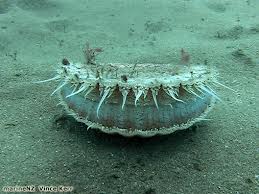 There is a range of fishing and boating clubs in most areas. These should be contacted as early as possible. The more and earlier they are involved in the planning and consultation work, the better. For the many fishermen that don't belong to a club, public meetings and media releases can be used to get the word out.
There is a range of fishing and boating clubs in most areas. These should be contacted as early as possible. The more and earlier they are involved in the planning and consultation work, the better. For the many fishermen that don't belong to a club, public meetings and media releases can be used to get the word out.
In working with recreational fishers it is really important to start with listening to their concerns and then to spend ample time distributing information on the benefits, purpose and the urgent need for marine reserves. To most people, marine reserves are a very new idea and the initial fear of losing a fishing ground is a substantial barrier to overcome.
In meetings and in information campaigns it is wise to concentrate on the biodiversity purpose and benefits. Avoid getting into discussions on 'rights' and non-extractive uses of the sea because these arguments are often of little interest to fishermen concerned about marine reserves. They may be quite interested in marine biodiversity and ecological discussions. Another good topic for discussion is the idea of restoring some of the spectacular abundances the local coast used to have before the impacts of fishing. Ironically, it can be hard to find stories, photos etc. of what marine life was like before modern fishing. But this process of discovering the past is a healthy one and leads to the idea of setting up a marine reserve so that all can see what a natural part of the coast would be like etc. The education argument associated with this is very powerful.
We urge you to research the arguments concerning the benefits of marine reserves carefully, and get out there in the community and make a start. See the Benefits focus group in the Social Science & Community Engagement resource list page in the Library.
Dealing with vocal opposition
It is likely that in any campaign you will strike a situation where you have to deal with a very vocal opposition. Thankfully this is usually a minority, but it is important to be able to respond. Some advice:
➢ In a public forum, always arrange to have a competent and (hopefully) respected facilitator
➢ Listen respectfully
➢ Don't debate or argue. In most cases the anger is not actually about marine reserves and if a person is in a state of anger sufficient for them to loudly attack you or your group's work in a public forum, it is highly unlikely any amount of arguing from you will change the person's approach – they have literally come for a fight, so that is precisely what not to give them
➢ Ask questions that lead the discussion back to the biodiversity aim of marine reserves, like:
- What are your concerns with the marine environment?
- Do you think fishing is improving?
- Do you think marine life has changed on our coast in 20 years? In 100 years?
- What would you like to see preserved for your grandchildren?
- Where can schoolchildren go to experience or study marine life in its natural state?
You will be amazed at how well the questioning strategy works - try it.
We strongly suggest that you spend time summarizing your arguments and becoming familiar with the resources on this website.
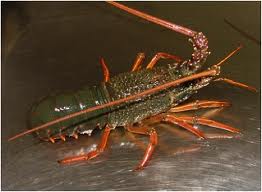 Packhorse crayfishSee also these sections within the past marine reserve application and proposal document, which specifically address recreational fishing. At the business end of your proposal or formal application stage under the Marine Reserve Act you will need to be able to report of your finding in the two important aspects below:
Packhorse crayfishSee also these sections within the past marine reserve application and proposal document, which specifically address recreational fishing. At the business end of your proposal or formal application stage under the Marine Reserve Act you will need to be able to report of your finding in the two important aspects below:
➢ Consultation with recreational fishing interests
➢ Implications of reserve establishment for recreational fishers
You will find many useful examples of responses to questions and answers to objections by going through the past applications and proposal documents.
Commercial Fishers
Commercial fishing interests are obviously key stakeholders in the marine environment. The Marine Reserves Act 1971 requires that any marine reserve must not unduly restrict a commercial quota holder from successfully taking his or her quota.
It is important to recognize that commercial fishermen can often be invaluable sources of information and local knowledge, and can furthermore be supportive of marine reserves because they are so intimately involved with the sea and marine biodiversity. Ironically, retired commercial fishermen can often be the most receptive to marine reserve proposals as they have lived through the experience of serial decline in a fishery, most notably in the inshore fisheries. So this is a crucially important group of people to work with.
The most common complaint from fishers, both recreational and commercial, is that they have not been involved in planning a marine reserve, or specifically in site selection and investigation. Make sure your contacts with fishing interests are made as early as possible.
The starting point for this part of planning and consultation is to establish a contact person in the MPI.
However contacts are made and maintained, you are best to talk to the commercial fisherman that fish in the 'area of interest' of your proposed marine reserve site. In these talks, you should try to find out as much as possible about the fishing that takes place in the area of consideration for a marine reserve, and the fishermen's views on any proposed boundaries etc.
Once you begin the process of consulting with fishermen, you will probably soon run up against challenges in getting the information you are seeking. At the end of this section, we provide you with two past reports on impacts to commercial fishing of proposed marine reserves at Mimiwhangata and in Bay of Islands.
There are several sections within the formal marine reserve application document which must specifically address commercial fishing. See our advice on the kind of information, and level of detail, needed to write these sections:
➢ Consultation with commercial fishing interests
➢ The implications of reserve creation for commercial fishers
The Catch Information Challenge
The marine reserve establishment process requires that the applicant research the impact of a proposed marine reserve on all user groups. In the case of commercial fishers, the logical process would be to examine catch histories for the area of interest for a marine reserve and probably for adjacent areas. It would then be logical to compare this data with catch data for the entire quota area that the fishermen involved fish in.
In practice, this is an unbelievably difficult, possibly impossible process.
Here are the reasons for the problem:
➢ Quota areas which form the basis for data collection are large. Quite often the scale of a proposed marine reserve is dwarfed by the size of the quota area, making extraction of data relevant to a specific area impossible.
➢ Not all data is publicly available. Some of it is not accessible for reasons of commercial confidentiality.
➢ MinFish now has industry-based contract arrangements for data collection and storage, sometimes resulting in the data being highly filtered or amalgamated by the time it gets to you.
➢ If you go to individual fishers, fishing companies or fish processors and ask for catch records, there is a long list of reasons why you may not get the data you seek. In many circumstances, fishers have quite valid reasons not to let specific information out about exactly where fish are caught so as to protect their local knowledge etc.
➢ Because individual fishers are only required to document fish catch in relation to quota area, any information they supply on a small specific area may not be documented, audited by anyone or in some cases accurate. Unfortunately, you or anyone else have no way to verify this type of information received from individual fishers.
What to do
Now that you have some idea of the challenge of getting information together on possible implications for fishing in the area of interest of your proposed marine reserve, here are some strategies:
➢ You don't have to solve this problem all by yourself – you should go to both DoC and MPI contact people and ask for help to do the best possible job of assembling available information.
➢ The fact that quota areas are very large in comparison to marine reserve areas makes the analysis of data difficult. However, it can also be an advantage in terms of legal argument and the criteria for a formal marine reserve application must meet. If the marine reserve area is very small in comparison to the quota area, it is then a logical argument that the marine reserve does not unduly affect the quota holders' ability to catch their quota...
➢ Actually, the Marine Reserve Act 1971 does not spell out how detailed any data has to be to resolve this issue. Both the Fisheries Act and the Protocol on Marine Reserves between DoC and MinFish state in their 'Information Principles' that any decision should be based on the best available information. Your responsibility is to do the best that you can, and that is the level of information decisions will be based on.
➢ It is worth remembering that many other management decisions relating to the sea and fisheries are currently being based on very little actual information, especially relating to specific areas. Furthermore, in a biodiversity and ecology context, little is known (or considered, normally) about indirect impacts of fishing on marine life. In other words, fishing is practised virtually everywhere with very little evidence that it is sustainable in a biodiversity or ecological sense. The fact that there is poor data on fishing in any specific area or impacts of that fishing is one of the best arguments for setting up a marine reserve.
➢ Marine reserve areas are a 'control area' in a scientific sense for the 'experiment' of fishing. Marine reserves are the small bit where the system is left undisturbed and as natural as possible. It follows that data collection should be centred on the justification of fishing, not on whether a marine reserve adversely affects fishing. Put another way, a certain percentage of all habitats should be set aside as marine reserves based on the principle that this is a good idea...
Ministry of Primary Industries (MPI)
Working with MPI, formerly the Ministry of Fisheries, is an important aspect of formulating a marine reserve application. The Marine Reserve Act 1971 requires the Minister of Fisheries to concur with the Minister of Conservation in ultimately accepting a marine reserve application. The Minister of Fisheries is mindful of his or her responsibilities under the Fisheries Act in carrying out this concurrence role.
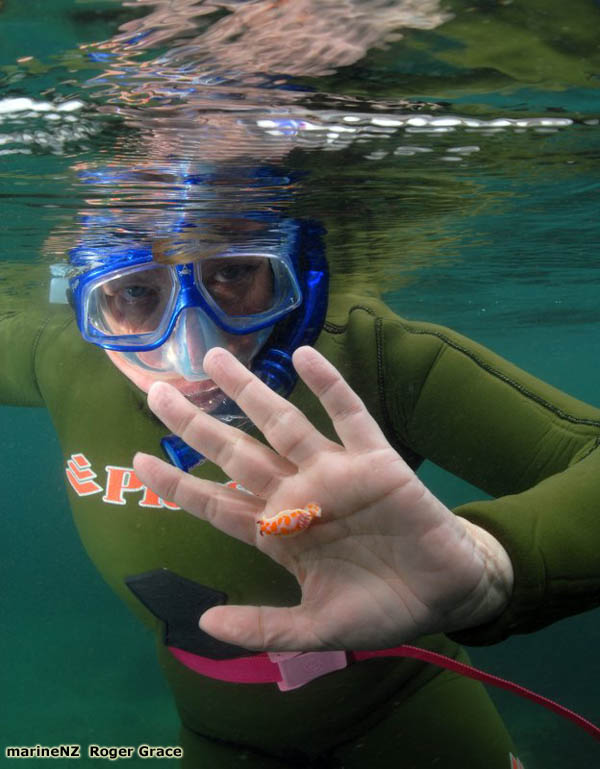 EMR snorkeler encounters a clown nudibranchIn practice, this means that the Minister is mainly looking at whether customary fishing, commercial fishing and recreational fishing will be 'unduly' affected by the establishment of the proposed marine reserve.
EMR snorkeler encounters a clown nudibranchIn practice, this means that the Minister is mainly looking at whether customary fishing, commercial fishing and recreational fishing will be 'unduly' affected by the establishment of the proposed marine reserve.
To assist in getting your part right, it is important to establish a working relationship with a contact in MPI to assist and guide you through the information-gathering process. You will need to be a bit patient and persistent with this task as you will find that the suitable contact person may not be immediately obvious.
MPI staff typically have large workloads, and working with marine reserve applicants is not normally part of their job. Start with your local office, and if necessary go to the regional or head office to find someone who you can work with. In most cases, local MPI staff are quite helpful in giving you a list of contacts of local commercial fishers.
Most fishing data is held in Head Office in Wellington. A lot of the actual work of maintaining the fisheries data is completed via a contract with a business that focuses solely on this one task. Various fisheries officials that work with the data can make requests to the data managers for specific reports or data outputs. If possible you should fine-tune your data request and put it to one of the officials working in the area in Head Office of MPI. If you are faced with the response, "we are sorry but that data is commercially sensitive and we can't give that to you" you should then ask if the commercially sensitive part of the data set you are requesting is filtered out e.g. the fisher's name is removed before it is given to you. That should work.
Another very good source of data is the MPI website online GIS system NABIS. On this site, you can search many data sets and display them on a map. You can save or copy maps and also download related documents. You will find that the data sets corresponding to the management areas are very large in scale as previously mentioned. This reflects how data is actually collected from fishers and the scale that management decisions are actually being made on.
You may also find it useful to explore the many fisheries reports that are accessible from the MPI fisheries information web page.
Here are two very good examples of studies of potential impacts of proposed reserves on commercial fishing.
Fish Forever, Commercial Fishing Bay of Islands by John Booth
DoC, Commercial Fishing Mimiwhangata prepared by Alan Flemming
Department of Conservation (DoC)
Our advice to all groups or individuals is quite simple.
You must seek out the 'right' person(s) to work with. As a result of the several rounds of downsizing and restructuring in the last 10 years, there is a high probability that in your local DoC office there will be no staff with specific marine conservation responsibilities. Most work in marine conservation planning and technical support for marine protected area processes around the country is done by a national marine technical team based in Wellington. It may be a good idea to ask your local DoC office to help you establish a relationship with someone on the national marine team. If that does not happen you should contact them directly. You can contact DoC head office directly from this general enquires web page.
• Establish a relationship and full communication with a DoC contact person as a first step before you proceed with any other planning or work. Regardless of whether or not they are actively involved in the early stages of your project, they will become a key player in the end stages of the campaign in a statutory role.
• Go to your local DoC office and find someone who is interested in marine conservation and motivated to support your efforts.
• Start at the local A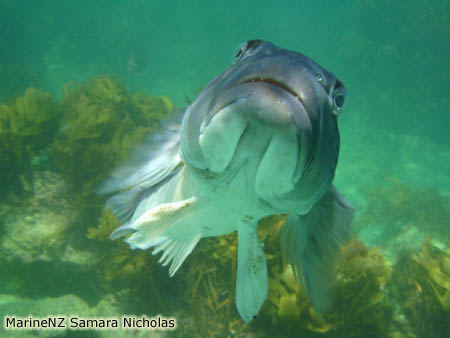 rea office, but realise that not every Area office has a marine 'interested' person.
rea office, but realise that not every Area office has a marine 'interested' person.
• Be prepared to go to your Conservancy office to seek someone that is appropriate to work with.
• Ask to make a presentation to your Conservancy Conservation Board as a way of gaining support and making contacts in the organisation.
• Don't be confused by job titles. The right person may be in a community relations position, a management position or a technical position.
• If none of the above work for you, cultivate a contact with a regional or head office person who can then assist you with finding someone that you can work with.
• Be clear about your purpose and commitment and what you are entitled to do under the Marine Reserve Act. Expect commitment and support from DoC, but realise that as an organisation they have very few marine staff and little funding.
